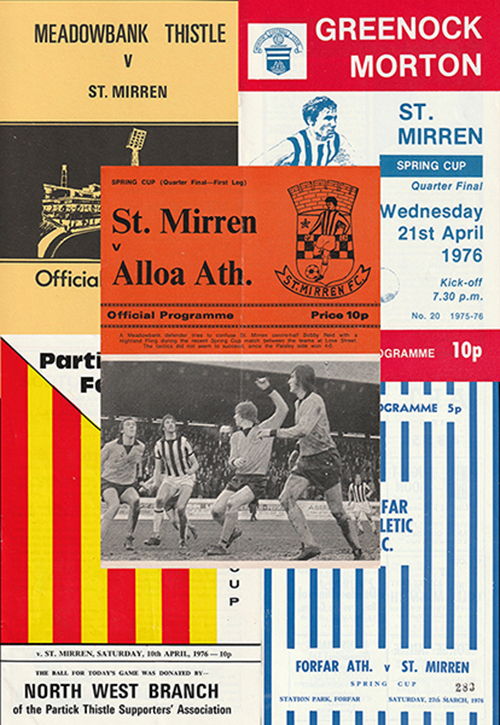St. Mirren in the Spring Cup (1976)
(first published in the match programme for St. Mirren v Kilmarnock, 11th May 2024)
With the advent of League reconstruction in season 1975/76, the Scottish League introduced a competition for the clubs of the new First and Second Divisions called the Spring Cup. The new League set-up had caused a reduction in the number of lower division fixtures to 26, and the new competition was intended to make up the shortfall and continue to provide much needed pools money for the competing clubs.
The new competition was immediately unpopular and claims were made that it would impose an additional financial burden on all but the most successful clubs. Managers made no secret of the fact that they would treat the games merely as preparation for the new season and, even before the first ball was kicked, calls were being made to provide an alternative.

Spring Cup 1976
The competition was run along similar lines to the Scottish League Cup format of the time. Seven sections of four clubs faced each other on a home and away basis on successive Saturdays. Originally it had been intended that only the winners of each section, together with the best second placed team, would continue on to a knock out phase. However, a few days before the competition began, it was revamped to allow sixteen qualifiers, comprising the top two teams from each section and the two best third placed teams. The remaining twelve non-qualifiers would receive 400 compensation.
St. Mirren were drawn in Section 3 alongside Partick Thistle, Meadowbank Thistle and Forfar Athletic and won five of their six matches to top the group. Their 18 goals scored and just three conceded was the best record of all the teams in the opening round.
By the end of the sectional ties, the worst fears of the participants had been realised. The competition had not been the crowd-puller the League had hoped for, with many attendances struggling to reach four figures and there were renewed calls for something better.
The second round was played on a home and away basis. Saints defeated Alloa Athletic 3-0 in the first tie at Love Street, following this up with a 4-1 victory at Recreation Park in the return match.
Their reward was a quarter final derby pairing with Morton. The Greenock side took a slender 1-0 lead from Cappielow into the second leg at Paisley. Before a crowd of 6,000, one of the biggest crowds of the tournament, Saints tried hard to overcome the deficit, but Morton scored in the last minute to earn a 2-0 aggregate win.
The day after the quarter finals, the First and Second Division clubs voted to scrap the Spring Cup altogether and to adopt Albion Rovers' proposal for the teams in the two divisions to meet each other three times a season. Even though this meant that there would be inequalities in the League programme - one team may have to play a stronger opponent once at home and twice away - the fact that the proposal was adopted showed the depth of feeling amongst the clubs about the present set-up.
Although St. Mirren had been eliminated, the Spring Cup retained a presence in Paisley with Love Street hosting the first semi-final between Airdrie and Morton. The Broomfield side won 3-1, whilst in the other semi at Firhill, Clydebank defeated Dumbarton by the same scoreline.
In the Final at Firhill, Bankies scored early but failed to capitalise with a missed penalty on the hour mark. Airdrie equalised late on to take the tie to extra time and were too strong in the added period, running out 4-2 winners.
The final irony of the competition came on the morning of the final. The League, perhaps with some foresight that the competition would not last, had not engraved the trophy and asked the winners to return it after a year. The reason given was that as the trophy was worth 250, it was deemed too expensive to give away.
The number of games played in the Spring Cup and the fact that it turned out to be a "one-off" competition makes it a suitable subject for a relatively small and interesting programme collection. Unlike the normality of modern-day programme production, a number of clubs frequently failed to issue on a regular basis during the 1970s and the novelty of the Spring Cup did nothing to alter this. For those clubs who did issue, only standard league programmes were produced. In the latter stages, the short time intervals between ties resulted in reduced issues or none at all. Indeed, the semi-finals and final saw no programmes issued.
Programmes were produced for all of St. Mirren s matches, with the exception of the away tie against Alloa, who were one of the non-issuing clubs that season. The home programme against Alloa was also incorrectly marked as a Quarter Final tie. All nine issues are still available, although some patience is needed to complete the set.

